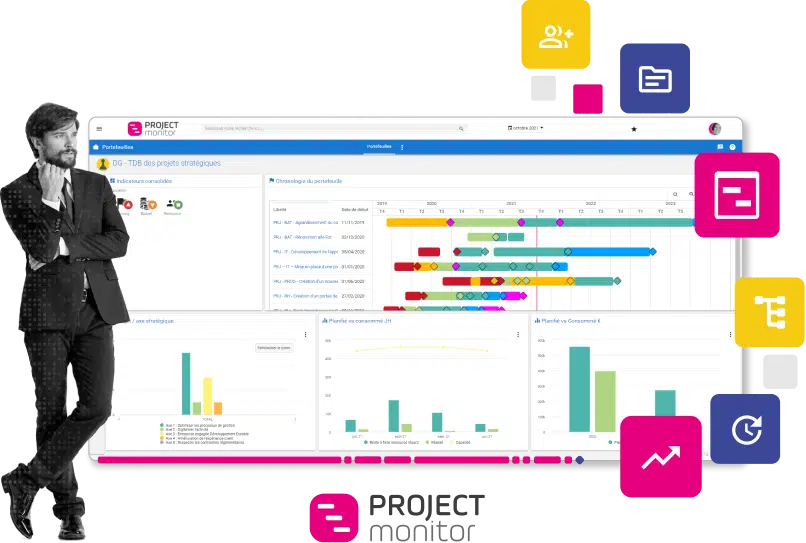What are the 4 dimensions of project planning?
Project planning plays a crucial role in the successful completion of a project, requiring an approach tailored to its specific requirements. However, four fundamental dimensions transcend all projects: defining objectives, identifying milestones, estimating resources and creating a schedule.
These dimensions encompass task management, resource optimization and risk management, playing an essential role in reducing uncertainties and increasing the chances of project success.
In this article, we'll explore these four pillars of project planning, before detailing the major steps involved.
What are the components of planning?
The four main dimensions of project planning are :
1. The scope dimension: This encompasses the precise definition of the project's objectives, deliverables and expected results. It involves clearly defining what is to be achieved, thus defining the scope of the project.
2. The time dimension: This concerns the definition of project stages and deadlines. This includes establishing a detailed schedule with start and end dates for each task or phase, as well as identifying critical deadlines and milestones.
3. The resources dimension: This dimension involves identifying, allocating and managing the resources needed to complete the project. This encompasses the human resources (skills and manpower required), material resources (equipment, tools, etc.) and financial resources (budgets) needed to carry out the project effectively.
4. The quality dimension: This aims to define the quality standards and criteria that the project must meet. This includes identifying the quality requirements for the project's deliverables and processes, as well as the quality control and assurance mechanisms to guarantee compliance with these standards.
Other commonly cited dimensions include :
- The how and where dimension: Define how the different stages of the project will be carried out and the means that will be used to achieve the objectives set.
- Managing potential obstacles: Identify risks that could impede the project's progress, and develop strategies to manage them effectively.
By combining these dimensions in a balanced way, project planning becomes more robust and enables more effective overall management throughout the project.
What are the main stages in project planning?
For successful project planning, follow these key steps:
- Define the project's objectives: What is the project's goal? What do you want to achieve?
- Identify the steps involved: What phases of the project need to be completed to reach the objectives?
- Evaluate the resources required: What human, financial and technical resources are needed to carry out the project?
- Establish a schedule for the project: By what date must each stage be completed?
- Communicate the project plan to stakeholders: Make sure everyone involved in the project understands what needs to be done and when.
- Monitor project progress and adjust if necessary: Make sure the project is progressing according to plan, and make adjustments if necessary.
To find out more about these key stages, read our detailed article on the subject.
💡Howcan project portfolio management software such as Project Monitor help in the planning of a set of projects?
When managing a set of projects, planning plays an essential role, enabling projects to be prioritized and prioritized, while optimizing the allocation of the organization's resources. The use of project portfolio management (PPM) software such as Project Monitor :
- facilitates this planning by providing an efficient means of organizing and tracking projects,
- ensures that projects are aligned with the organization's strategic objectives, while maximizing the use of available resources,
- helps identify and manage project risks,
- reduce the risk of failure and increase the probability of success.
- improves communication and collaboration within the organization.
Thanks to centralized monitoring, stakeholders remain informed of the progress of each project, promoting smooth coordination and ensuring that projects progress according to schedule and objectives.
Here are some additional benefits of using PPM software:
- Improved visibility:Project Monitor gives you better visibility of all your projects in a single platform, helping you to identify and resolve problems earlier.
- Improved efficiency:Project Monitor improves efficiency by automating low-value-added tasks and making it easier for you to collaborate with other project team members.
- Improved decision-making:Project Monitor facilitates decision-making by providing you with consolidated, up-to-date information on the status of your projects.
Other articles on project planning
Why is project planning important?
What elements should be included in project planning?
What are the tools for operational planning?
What are the stages in project planning?
What are the 4 dimensions of project planning?
What is project planning?
How is project planning carried out?
Who is responsible for project planning?
Project Monitorproject portfolio management software
A single software package for efficient planning and management of your project portfolios
Discover its features, specially designed to meet the needs of PMOs, CIO and organizations with more than 50 employees, as well as for the management of complex projects.
With Project Monitor, you can easily manage over 100 active projects and monitor your action plans. Get a complete overview of the status of your project portfolios, including resources, schedule, budget and dashboards. "
